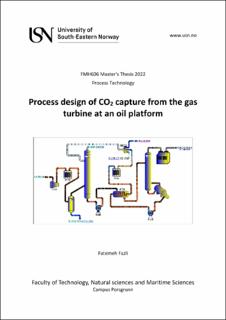| dc.description.abstract | Human activities and the ever-increasing growing need for energy, have significantly increased the concentration of carbon dioxide. Fossil fuels have established a huge impact to provoke these emissions especially in an offshore application. This tragedy and its consequences, such as global warming and climate change, temperature increase, and also sea level increase, have prompted international organizations all over the world, to set an international framework to control and reduce the adverse effects of greenhouse gas emissions.
In order to remove the CO2 emissions, several methods have been proposed, but among all, capturing CO2 by amine-based absorption column seems to be one of the best alternatives. In this project, a standard amine-based CO2 removal process plant for an offshore application as a request of Moreld Apply has been investigated in Aspen HYSYS software. Due to the restriction in space and weight on the offshore platforms, a wide optimization has been conducted and the impact of parameter changes has been evaluated.
In this study, to meet Moreld Apply AS needs for one of their projects on an offshore platform in the North Sea in Norway, a simplified standard CO2 capture process plant has been simulated and designed in Aspen HYSYS. This unit has been missioned to remove the CO2 content of flue gas with 90 % efficiency from the Waste Heat Recovery Unit (WHRU) package which is itself working with two parallel gas turbines, steam turbine, reboiler, condenser and a heat exchanger. The WHRU package was in scope of two bachelor students at USN working in parallel with this study, and this work covers the CO2 removal process plant simulation and design, dimensioning, cost estimation, as well as optimization.
Having this purpose, a base case model has been developed in which a minimum approach temperature (ΔTmin) of 10 °C has been assumed in the main heat exchanger and was specified to have 90 % removal efficiency, packing height in an absorber column was calculated to 16 meter and 3.6 MJ energy in the reboiler per mass of CO2 captured. Since the CO2 capture plant is an expensive process especially in an offshore application, a sensitivity analysis has been conducted to investigate the process dependency on some parameter changes, one is changing number of packing height in the absorber column from 10 to 16 meter, and also change of minimum approach temperature (ΔTmin) in range of 10, 15, and 20 °C. During these parameter changes, circulation rate, energy demand per kilogram of CO2 removal, the ratio of CO2 content to the amine content from the bottom outlet in the absorber column, steam and electricity consumption have been evaluated. As a suggestion for a more optimum solution of this study, minimum approach temperature of 15 °C and an absorber column with 13-meter packing height with 87 % efficiency have been suggested which requires 5.5 MJ energy in the reboiler unit to remove one kilogram of CO2 during the process. | |
